General characteristics of the liquid state
Liquid is one of the aggregate states of matter. The main property of a liquid, which distinguishes it from other states of aggregation, is the ability to change its shape indefinitely under the action of tangential mechanical stresses, even arbitrarily small, while practically maintaining volume.
The liquid state is usually considered intermediate between a solid and a gas: a gas retains neither volume nor shape, while a solid retains both.
The shape of liquid bodies can be wholly or partly determined by the fact that their surface behaves like an elastic membrane. So, water can collect in drops. But the liquid is capable of flowing even under its immovable surface, and this also means non-conservation of the form (of the internal parts of the liquid body).
The molecules of a liquid do not have a definite position, but at the same time, they do not have complete freedom of movement. There is an attraction between them, strong enough to keep them close.
A substance in a liquid state exists in a certain temperature range, below which it passes into a solid state (crystallization occurs or transformation into a solid amorphous state - glass), above - into a gaseous state (evaporation occurs). The boundaries of this interval depend on the pressure.
Determine the picture of processes in the phenomena of capillarity, wetting, viscosity, surface tension.
Capillarity, capillary effect - physical phenomenon, which consists in the ability of liquids to change the level in tubes, narrow channels of arbitrary shape, porous bodies. The rise of the liquid occurs when the channels are wetted with liquids, for example, water in glass tubes, sand, soil, etc. The decrease in liquid occurs in tubes and channels that are not wetted by liquid, for example, mercury in a glass tube. On the basis of capillarity, the vital activity of animals and plants, chemical technologies, and everyday phenomena are based (for example, lifting kerosene along the wick in a kerosene lamp, wiping hands with a towel).
Wetting is surface phenomenon, which consists in the interaction of a liquid with the surface of a solid or other liquid. Wetting is of two types:
Immersion (the entire surface of a solid body is in contact with a liquid)
Contact (consists of three phases - solid, liquid, gaseous)
Wetting depends on the ratio between the adhesion forces of liquid molecules with molecules (or atoms) of the wetted body (adhesion) and the forces of mutual adhesion of liquid molecules (cohesion).
Viscosity (internal friction) is one of the transfer phenomena, the property of fluid bodies (liquids and gases) to resist the movement of one of their parts relative to another. The mechanism of internal friction in liquids and gases lies in the fact that randomly moving molecules transfer momentum from one layer to another, which leads to equalization of velocities - this is described by the introduction of a friction force. The viscosity of solids has a number of specific features and is usually considered separately. A distinction is made between dynamic viscosity (measurement units: poise, 0.1 Pa s) and kinematic viscosity (measurement units: stokes, m²/s, off-system unit - degree Engler). Kinematic viscosity can be obtained as the ratio of dynamic viscosity to the density of a substance and owes its origin to the classical methods of measuring viscosity, such as measuring the time it takes a given volume to flow through a calibrated orifice under the influence of gravity.
Surface tension is a thermodynamic characteristic of the interface between two phases in equilibrium, determined by the work of the reversible isothermokinetic formation of a unit area of this interface, provided that the temperature, volume of the system and chemical potentials of all components in both phases remain constant. The surface tension has a double physical meaning- energy (thermodynamic) and power (mechanical). Energy (thermodynamic) definition: surface tension is the specific work of increasing the surface when it is stretched, provided that the temperature is constant. Force (mechanical) definition: Surface tension is the force acting per unit length of a line that limits the surface of a liquid.
How do they explain the large heat capacity of water, the large surface tension and the property of capillarity?
All these features are associated with the presence of hydrogen bonds. Due to the large difference in the electronegativity of hydrogen and oxygen atoms, electron clouds are strongly shifted towards oxygen. Due to this, as well as the fact that the hydrogen ion (proton) does not have internal electron layers and has small dimensions, it can penetrate into electron shell negatively polarized atom of the neighboring molecule. Due to this, each oxygen atom is attracted to the hydrogen atoms of other molecules and vice versa. A certain role is played by the proton exchange interaction between and within water molecules. Each water molecule can participate in a maximum of four hydrogen bonds: 2 hydrogen atoms - each in one, and an oxygen atom - in two; in this state, the molecules are in an ice crystal. When ice melts, some of the bonds break, which allows the water molecules to be packed more densely; when water is heated, the bonds continue to break, and its density increases, but at temperatures above 4 ° C, this effect becomes weaker than thermal expansion. Evaporation breaks all remaining bonds. Breaking bonds requires a lot of energy, hence the high temperature and specific heat of melting and boiling and high heat capacity. The viscosity of water is due to the fact that hydrogen bonds prevent water molecules from moving at different speeds.
What is the significance of these features of water in wildlife?
High specific heat capacity.
In combination with high thermal conductivity, this makes the aquatic environment comfortable enough for living organisms to live. Due to the high heat capacity and thermal conductivity, the aquatic environment, unlike the air environment, is less susceptible to temperature changes (both daily and seasonal), which facilitates the adaptation of animals and plants to this abiotic factor.
High surface tension and cohesion.
Due to surface tension, the liquid tends to take such a shape that its surface area is minimal (ideally, the shape of a ball). Of all liquids, water has the highest surface tension. Significant cohesion plays an important role in living cells, as well as in the movement of water through vessels in plants. Many small organisms benefit from surface tension: such organisms form the neuston ecological group, which is divided into epineuston (those that move on the surface of the film, like a water strider), and hyponeuston, organisms that attach to the surface film in the water (larvae of some flies and mosquitoes).
Capillary phenomena play an essential role in the water supply of plants, the movement of moisture in soils and other porous media. Capillary impregnation of various materials is widely used in various technological processes. Capillary phenomena play an equally important role in the formation of a new phase: liquid drops during vapor condensation and vapor bubbles during boiling and cavitation.
Capillary phenomena play an important role in nature and technology. The rise of the nutrient solution along the stem or trunk of a plant is largely due to the phenomenon of capillarity: the solution rises through thin capillary tubes formed by the walls of plant cells. Through the capillaries of the soil, water rises from the deep to the surface layers of the soil. Conversely, by loosening the soil surface and thus creating discontinuities in the soil capillary system, it is possible to delay the flow of water to the evaporation zone and slow down the drying of the soil.
Capillary phenomena play an essential role in the water supply of plants and the movement of moisture in the soil. In dry weather, the soil shrinks, and cracks form in it - capillaries. Through them, water rises from the ground up and evaporates. Because of this, the surface of the earth dries out even more. To preserve moisture inside the earth, the topsoil is loosened. In this case, the capillaries are destroyed and water remains in the soil.
Short-range order (fluidity, incompressibility, quasi-crystallinity, potential energy of molecules).
surface tension.
Pressure under a curved surface.
Wetting.
capillary phenomena.
Surface tension.
The potential energy of a molecule inside a liquid is less than outside the liquid. The surface layer is in different conditions. To transfer molecules to the surface, a certain potential barrier must be overcome.
r- radius of molecular action (sphere of molecular action).
The resulting force inside the liquid is 0. On the surface of the gas - its action can be neglected. The resulting force is reduced. The entire layer lying near the surface of the liquid is subjected to forces directed normally into the liquid. The surface layer exerts pressure on the liquid - molecular pressure.
The mass of fluid, which is not acted upon by external forces, must take on a spherical shape. Of all geometric bodies A sphere has the smallest surface area for a given volume. The surface of a liquid is like a stretched film. To stretch a film, normally a force must be applied to its boundary  tangent to the surface of the liquid, called the surface tension force. These forces are the greater, the longer the length of the film boundary:
tangent to the surface of the liquid, called the surface tension force. These forces are the greater, the longer the length of the film boundary:

 - coefficient of surface tension. FROMT
- coefficient of surface tension. FROMT and
and  . AtT
. AtT 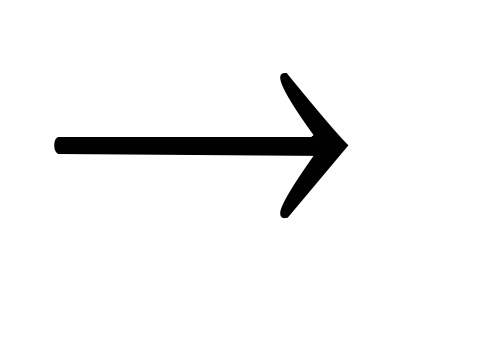 T Crete.
T Crete.
 0
. Let
0
. Let  - some platform.
- some platform.  - work to create her strengthF.
- work to create her strengthF.

then

This work goes to increase the energy of the film:


Surface tension energy.
Energy - is a part internal energy film, which is converted into work during an isothermal process.
Free energy
Surface tension explains: droplet formation:

For a drop:

Pressure under curved surface
Consider the surface of the liquid, based on a flat contour.

If the surface of the liquid is not flat, then its tendency to contract will lead to the addition of pressure in relation to the flat liquid.
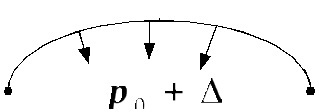
In the case of a convex surface, this pressure is positive; in the case of a concave one, it is negative.


Compute
 for a spherical liquid surface.
for a spherical liquid surface.

Due to surface tension, both hemispheres are attracted.


These forces press both hemispheres on the surface, and they cause additional pressure:

Surface curvature:

In geometry, it is proved that the half-sum of the reciprocal radii of curvature of any pair of mutually perpendicular sections has the same value H :

For sphere: R 1 = R 2 = R :

Laplace proved that the formulas are valid for a surface of any shape, if H means the average curvature of the surface at the point at which the additional pressure is determined.
Average curvature

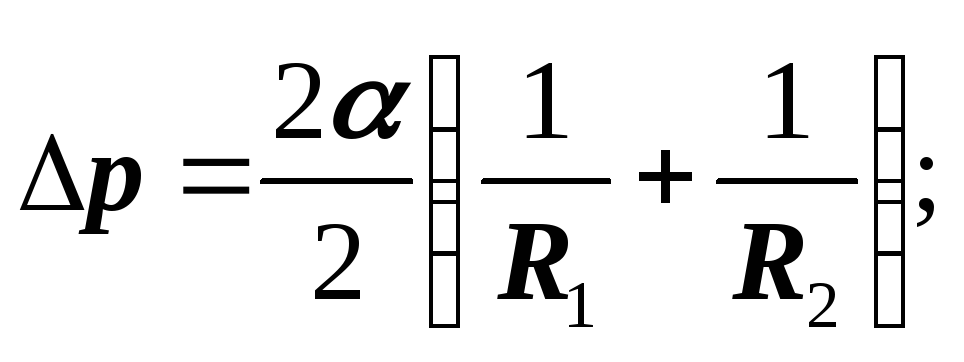
Laplace formula
Additional pressure changes the liquid level in narrow tubes (capillaries), which is sometimes called capillary pressure.
The floating of small bodies on the surface is explained by the Laplace pressure.
wetting
When considering phenomena at the liquid-solid boundary, it is necessary to consider the total surface energy of two substances.
If three substances border: liquid, solid and gas. Then the whole configuration corresponds minimum total energy (surface, in the liquid field).

Angle, between surface solid body and tangent to the liquid
 - edge angle.
- edge angle.
If a
 less than π/2 the liquid wets the body.
less than π/2 the liquid wets the body.
If a
 more than π/2 the liquid does not wet the body.
more than π/2 the liquid does not wet the body.
At
 zero total wetting.
zero total wetting.
At
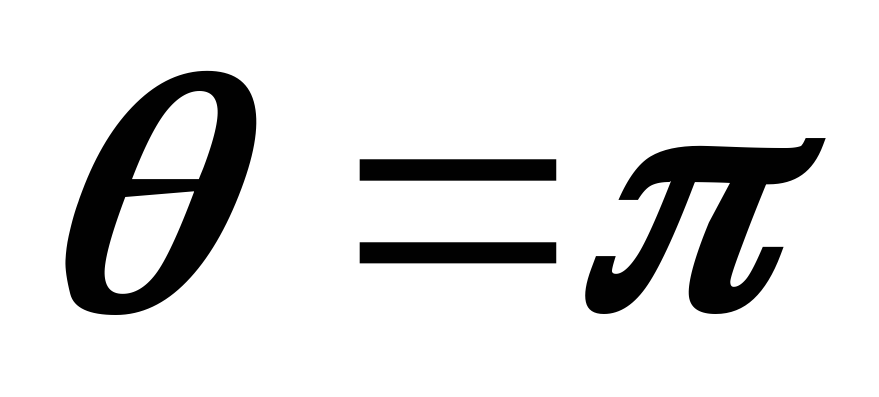 complete nonwetting.
complete nonwetting.
Non-wetting can lead to curious phenomena: a needle does not sink in fat. Similarly, you can carry water in a sieve if the sieve is not wetted by water (cover the sieve threads with paraffin), if there is not much water.
Capillary phenomena
The existence of the contact angle leads to the curvature of the liquid surface near the walls of the vessel. In a narrow capillary tube, the surface turns out to be curved.
The liquid wets the surface:

If the liquid does not wet:

If the surface of the liquid is curved, then the surface tension forces create additional pressure on the liquid:

In this way, total pressure equals:

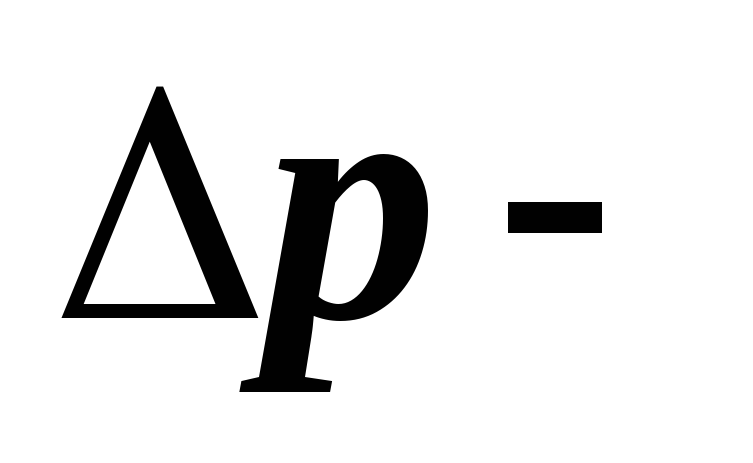 capillary, Laplacian pressure.
capillary, Laplacian pressure.
If the capillary is immersed with one end in a liquid, then when the capillary is wetted, the liquid level will be higher than the level in the vessel, and when not wetted, it will be lower.

Level height change in narrow tubes - capillarity.

If the capillaries are round section, then:
 and
and

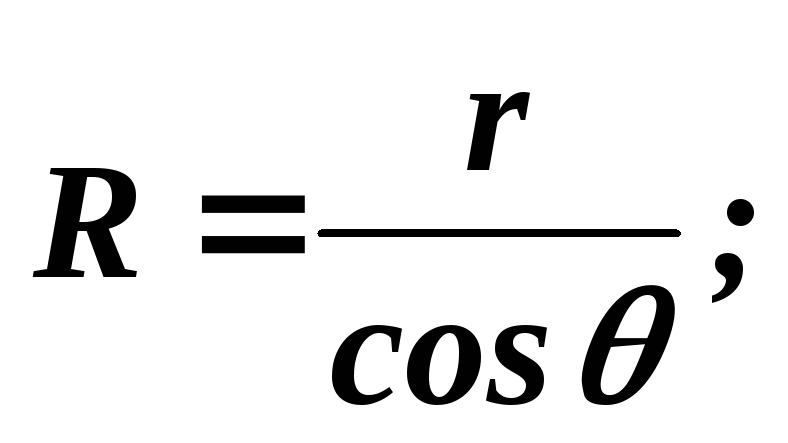
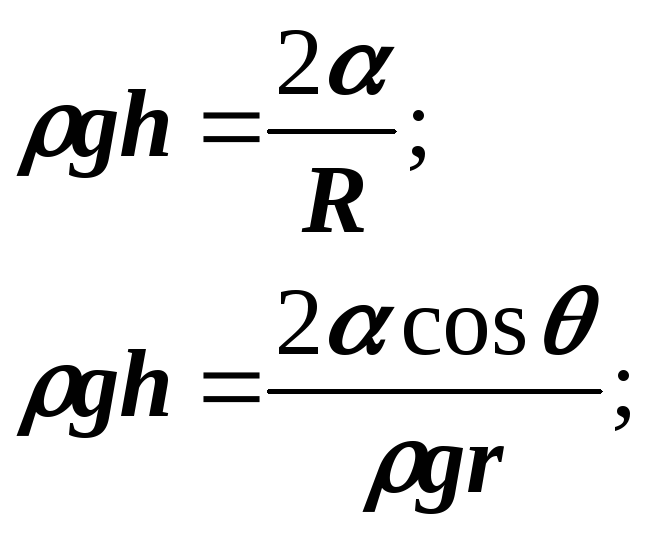

If the capillary is small, then with complete wetting
 :
:
R = r


Liquid - state of aggregation of matter, intermediate between solid and gaseous. Liquids have the inherent property of solids - to retain their volume, form a surface, transparency, tensile strength. Gases: take the form of a vessel, continuously turns into a gas without a jump.
A number of features peculiar only to her: Feature - fluidity. Liquids are almost incompressible. Fluid testing with x-rays showed that internal structure they have much in common with the structure of solids.
In the arrangement of liquid particles, there is short range order .
1. Liquid state of matter and its properties.
2.1 Bernoulli's law.
2.2 Pascal's law.
2.3 Laminar flow of liquids.
2.4 Poisel's law.
2.5 Turbulent flow of liquids.
3.1 Measuring the viscosity of a liquid.
3.2 Liquid volume and flow measurement
1. Liquid state of matter and its properties.
Liquids occupy an intermediate position between gaseous and solid substances. At temperatures close to boiling points, the properties of liquids approach those of gases; at temperatures close to melting points, the properties of liquids approach those of solids. If for solids strict ordering of particles is characteristic, extending over distances of up to hundreds of thousands of interatomic or intermolecular radii, then in a liquid substance there are usually no more than a few tens of ordered particles - this is explained by the fact that the ordering between particles in different places liquid substance arises just as quickly as it is again “smeared out” by the thermal oscillations of particles. At the same time, the total packing density of particles of a liquid substance differs little from that of a solid substance - therefore, their density is close to the density of solids, and the compressibility is very low. For example, to reduce the volume occupied by liquid water by 1%, it is required to apply a pressure of ~ 200 atm, while the same decrease in the volume of gases requires a pressure of the order of 0.01 atm. Therefore, the compressibility of liquids is approximately 200: 0.01 = 20,000 times less than the compressibility of gases.
It was noted above that liquids have a certain volume of their own and take the shape of the vessel in which they are located; these properties are much closer to those of a solid than a gaseous substance. Great proximity liquid state to solid is also confirmed by data on standard enthalpies evaporation ∆Н° use and standard enthalpies of fusion ∆Н° pl. The standard enthalpy of vaporization is the amount of heat required to convert 1 mole of liquid to vapor at 1 atm (101.3 kPa). The same amount of heat is released when 1 mole of vapor condenses into a liquid at 1 atm. The amount of heat spent on the transformation of 1 mol of a solid into a liquid at 1 atm is called the standard enthalpy of fusion (the same amount of heat is released when 1 mol of liquid at 1 atm “freezes” (“solidifies”). It is known that ∆Н° pl is much less than the corresponding values of ∆Н° exp, which is easy to understand, since the transition from solid state to liquid is accompanied by a lesser violation of intermolecular attraction than the transition from liquid to gaseous state.
A number of other important properties of liquids are more reminiscent of the properties of gases. So, like gases, liquids can flow - their property is called fluidity. The resistance to flow is determined by the viscosity. Fluidity and viscosity are affected by attractive forces between liquid molecules, their relative molecular weight, and a number of other factors. The viscosity of liquids is ~100 times greater than that of gases. Just like gases, liquids can diffuse, albeit much more slowly, since liquid particles are packed much more densely than gas particles.
One of the most important properties of a liquid is its surface tension (this property is not inherent in either gases or solids). A molecule in a liquid is subjected to uniform intermolecular forces from all sides. However, on the surface of the liquid, the balance of these forces is disturbed, and as a result, the “surface” molecules are under the action of a certain resultant force directed inside the liquid. For this reason, the surface of the liquid is in a state of tension. Surface tension is the minimum force that restrains the movement of liquid particles into the depth of the liquid and thereby keeps the surface of the liquid from contracting. It is surface tension that explains the "teardrop" shape of freely falling fluid particles.
Due to volume conservation, the liquid is able to form a free surface. Such a surface is the phase interface of a given substance: on one side there is a liquid phase, on the other - a gaseous (steam), and, possibly, other gases, such as air. If the liquid and gaseous phases of the same substance are in contact, forces arise that tend to reduce the interface area - surface tension forces. The interface behaves like an elastic membrane that tends to shrink.
Surface tension can be explained by the attraction between liquid molecules. Each molecule attracts other molecules, seeks to "surround" itself with them, and therefore, to leave the surface. Accordingly, the surface tends to decrease. Therefore, soap bubbles and bubbles during boiling tend to take on a spherical shape: for a given volume, a ball has a minimum surface. If only surface tension forces act on a liquid, it will necessarily take on a spherical shape - for example, water drops in weightlessness.
Small objects with a density greater than the density of a liquid are able to "float" on the surface of the liquid, since the force of gravity is less than the force that prevents the increase in surface area.
Wetting is a surface phenomenon that occurs when a liquid contacts a solid surface in the presence of steam, that is, at the interfaces of three phases. Wetting characterizes the “sticking” of a liquid to the surface and spreading over it (or, conversely, repulsion and non-spreading). There are three cases: non-wetting, limited wetting and complete wetting.
Miscibility is the ability of liquids to dissolve in each other. An example of miscible liquids: water and ethyl alcohol, an example of immiscible liquids: water and liquid oil.
When two miscible liquids are in a vessel, as a result of thermal motion, the molecules begin to gradually pass through the interface, and thus the liquids gradually mix. This phenomenon is called diffusion (it also occurs in substances in other states of aggregation).
A liquid can be heated above the boiling point in such a way that boiling does not occur. This requires uniform heating, without significant temperature differences within the volume and without mechanical influences such as vibration. If in superheated liquid throw something, it instantly boils. Superheated water is easy to get in the microwave.
Subcooling - cooling of a liquid below the freezing point without turning into a solid state of aggregation. As with superheating, subcooling requires the absence of vibration and significant temperature fluctuations.
If the surface of the liquid is displaced from the equilibrium position, then under the action of restoring forces, the surface begins to move back to the equilibrium position. This movement, however, does not stop, but turns into oscillating motion near the equilibrium position and extends to other areas. This creates waves on the surface of a liquid.
If the restoring force is predominantly gravity, then such waves are called gravitational waves. Gravitational waves on water can be seen everywhere.
If the restoring force is predominantly a surface tension force, then such waves are called capillary. If these forces are comparable, such waves are called capillary-gravity waves. Waves on the surface of a liquid are attenuated by viscosity and other factors.
Formally speaking, for the equilibrium coexistence of a liquid phase with other phases of the same substance - gaseous or crystalline - strictly defined conditions are needed. So, at a given pressure, a strictly defined temperature is needed. Nevertheless, in nature and in technology everywhere liquid coexists with vapor, or also with solid state of aggregation- for example, water with water vapor and often with ice (if we consider steam as a separate phase present along with air). This is due to the following reasons.
Unbalanced state. It takes time for the liquid to evaporate, until the liquid has completely evaporated, it coexists with the vapor. In nature, water is constantly evaporating, as well as the reverse process - condensation.
closed volume. The liquid in a closed vessel begins to evaporate, but since the volume is limited, the vapor pressure rises, it becomes saturated even before the liquid has completely evaporated, if its amount was large enough. When the saturation state is reached, the amount of evaporated liquid is equal to the amount of condensed liquid, the system comes into equilibrium. Thus, in a limited volume, the conditions necessary for the equilibrium coexistence of liquid and vapor can be established.
The presence of the atmosphere in the conditions of terrestrial gravity. Affects the liquid Atmosphere pressure(air and steam), while for steam, practically only its partial pressure. Therefore, liquid and vapor above its surface correspond to different points on the phase diagram, in the area of existence of the liquid phase and in the area of existence of the gaseous, respectively. This does not cancel evaporation, but evaporation takes time during which both phases coexist. Without this condition, liquids would boil and evaporate very quickly.
2.1 Bernoulli's law - is a consequence of the law of conservation of energy for a stationary flow of an ideal (that is, without internal friction) incompressible fluid:
is the density of the fluid, is the flow velocity, is the height at which the considered element of the liquid is located, is the pressure at the point in space where the center of mass of the considered element of the liquid is located, is the acceleration of free fall.The constant on the right hand side is usually called pressure, or full pressure, and also Bernoulli integral. The dimension of all terms is a unit of energy per unit volume of liquid.
This ratio, derived by Daniel Bernoulli in 1738, was named after him. Bernoulli equation. For horizontal pipe h= 0 and the Bernoulli equation takes the form:
This form of the Bernoulli equation can be obtained by integrating the Euler equation for a stationary one-dimensional fluid flow, at a constant density ρ:
According to Bernoulli's law, the total pressure in a steady flow of fluid remains constant along this flow.
Full pressure consists of the weighted (ρ gh), static (p) and dynamic (ρν 2 /2) pressures.
It follows from Bernoulli's law that as the flow cross section decreases, due to an increase in velocity, that is, dynamic pressure, the static pressure decreases. This is the main reason for the Magnus effect. Bernoulli's law is also valid for laminar gas flows. The phenomenon of a decrease in pressure with an increase in the flow rate underlies the operation of various types of flow meters (for example, a Venturi tube), water and steam jet pumps. And the consistent application of Bernoulli's law led to the emergence of a technical hydromechanical discipline - hydraulics.
Bernoulli's law is valid in its pure form only for liquids whose viscosity is zero, that is, liquids that do not stick to the surface of the pipe. In fact, it has been experimentally established that the velocity of a liquid on the surface of a solid body is almost always exactly zero (except in cases of jet separation under certain rare conditions).
2.2 Pascal's law is formulated like this:
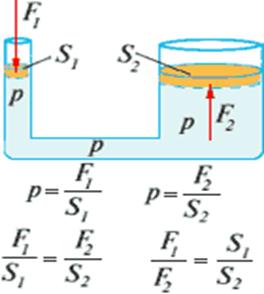 The pressure exerted on a liquid (or gas) in any one place on its boundary, for example, by a piston, is transmitted without change to all points of the liquid (or gas).
The pressure exerted on a liquid (or gas) in any one place on its boundary, for example, by a piston, is transmitted without change to all points of the liquid (or gas). Basic property of liquids and gases- transfer pressure without change in all directions - is the basis for the design of hydraulic and pneumatic devices and machines.
How many times the area of one piston is greater than the area of the other, the same number of times the hydraulic machine gives a gain in strength.
2.3 Laminar flow(lat. lamina- plate, strip) - a flow in which a liquid or gas moves in layers without mixing and pulsations (that is, random rapid changes in speed and pressure).
Laminar flow is possible only up to a certain critical value of the Reynolds number, after which it becomes turbulent. The critical value of the Reynolds number depends on the specific type of flow (flow in a round pipe, flow around a ball, etc.). For example, for a flow in a round pipe
The Reynolds number is determined by the following relation:
ρ is the density of the medium, kg/m 3 ;
v- characteristic speed, m/s;
L- characteristic size, m;
η - dynamic viscosity of the medium, N*s/m 2 ;
ν - kinematic viscosity of the medium, m 2 / s ();
Q- volumetric flow rate;
A- sectional area of the pipe.
The Reynolds number as a criterion for the transition from laminar to turbulent flow and vice versa works relatively well for pressure flows. When passing to free-flow flows, the transition zone between laminar and turbulent regimes increases, and the use of the Reynolds number as a criterion is not always justified. For example, in reservoirs, the formally calculated values of the Reynolds number are very high, although laminar flow is observed there.
2.4 Equation or Poiseuille's law- the law that determines the flow rate of a fluid in a steady flow of a viscous incompressible fluid in a thin cylindrical pipe of circular cross section.
According to the law, the second volumetric flow rate of a liquid is proportional to the pressure drop per unit length of the tube (pressure gradient in the pipe) and the fourth power of the radius (diameter) of the pipe:
- Q- fluid flow in the pipeline;
- D- pipeline diameter;
- v- fluid velocity along the pipeline;
- r- distance from the axis of the pipeline;
- R- pipeline radius;
- p 1 − p 2 - pressure difference at the inlet and outlet of the pipe;
- η is the viscosity of the liquid;
- L- pipe length.
Poiseuille's law works only for laminar flow and provided that the length of the tube exceeds the so-called length of the initial section, which is necessary for the development of laminar flow in the tube.
The Poiseuille flow is characterized by a parabolic velocity distribution along the radius of the tube. In each cross section of the tube average speed half the maximum speed in this section.
2.5 T urbulent t(from Latin turbulentus - turbulent, chaotic), the form of the flow of a liquid or gas, in which their elements make disorderly, unsteady movements along complex trajectories, which leads to intense mixing between layers of moving liquid or gas (see Turbulence). T. t. in pipes, channels, boundary layers near solids flowed around by liquid or gas, as well as so-called. free T. t. - jets, traces behind solids moving relative to a liquid or gas, and zones of mixing between flows of different speeds that are not separated by c.-l. solid walls. T. t. differ from the corresponding laminar flows both in their complex internal structure (Fig. 1), and in the distribution of the average velocity over the flow section and integral characteristics - the dependence of the average over the section or max. speed, flow, as well as the coefficient. resistance from the Reynolds number Re. The profile of the average velocity of the thermometer in pipes or channels differs from the parabolic one. profile of the corresponding laminar flow with a faster increase in velocity near the walls and less curvature towards the center. parts of the flow (Fig. 2). Except for a thin layer near the wall, the velocity profile is described by a logarithmic law (i.e., the velocity depends linearly on the logarithm of the distance to the wall). Drag coefficient:
- friction stress on the wall,is the density of the liquid,
- its speed, average over the flow section) is related to Re by the ratio

Average velocity profile: a - for laminar flow, 6 - for turbulent flow.
3.1 Fluid Viscosity Measurement .
Kinematic viscosity is a measure of the flow of a resistive fluid under the influence of gravity. When two liquids of equal volume are placed in identical capillary viscometers and move by gravity, the viscous liquid takes longer to flow through the capillary. If one fluid takes 200 seconds to flow out and another takes 400 seconds, the second fluid is twice as viscous as the first on the kinematic viscosity scale.
Absolute viscosity, sometimes called dynamic or simple viscosity, is the product of kinematic viscosity and fluid density:
Absolute Viscosity = Kinematic Viscosity * Density
The dimension of kinematic viscosity is L 2 /T, where L is length and T is time). SI UNIT kinematic viscosity - 1 cSt (centiStokes)=mm 2 /s. Absolute viscosity is expressed in centipoise (cPoise). SI UNIT of absolute viscosity - millipascal second 1 MPa * s = 1 cPas.
A device for measuring viscosity is called a viscometer. Viscometers can be classified into three main types:
BUT. Capillary viscometers measure the flow of a fixed volume of liquid through a small orifice at a controlled temperature. The shear rate can be measured from about zero to 106 s -1 by changing the capillary diameter and the applied pressure. Types of capillary viscometers and their modes of operation:
Glass capillary viscometer (ASTM D 445) - Liquid passes through a hole of a set diameter under the influence of gravity. The shear rate is less than 10 s -1 . The kinematic viscosity of all automotive oils is measured by capillary viscometers.
High Pressure Capillary Viscometer (ASTM D 4624 and D 5481) - A fixed volume of liquid is extruded through a diameter glass capillary under the action of an applied gas pressure. The shear rate can be changed up to 106 s -1 . This technique is commonly used to model the viscosity of engine oils in working main bearings. This viscosity is called the viscosity at high temperature and high shear (HTHS) and is measured at 150°C and 106 s -1 . HTHS viscosity is also measured with a tapered bearing simulator, ASTM D 4683 (see below).
B. Rotational viscometers use torque on a rotating shaft to measure the resistance of a fluid to flow. Rotational viscometers include cold cranking simulator (CCS), mini rotational viscometer (MRV), Brookfield viscometer, and tapered bearing simulator (TBS). The shear rate can be changed by changing the dimensions of the rotor, the gap between the rotor and the stator wall, and the rotational speed.
Cold Scroll Simulator (ASTM D 5293) - CCS measures apparent viscosity in the range of 500 to 200,000 cPas. The shear rate is between 104 and 105 s -1 . normal range operating temperature- from 0 to -40°C. CCS showed excellent correlation with engine starting at low temperatures. The SAE J300 viscosity classification defines the low temperature viscosity performance of engine oils by CCS and MRV limits.
Mini Rotary Viscometer (ASTM D 4684) - The MRV test, which is related to the mechanism of oil pumpability, is a measurement at low shear rate. main feature method - slow sample cooling rate. The sample is prepared to have a specific thermal history that includes heating, slow cooling, and impregnation cycles. The MRV measures the apparent residual stress, which, if greater than a threshold value, indicates a potential pumping failure problem due to air intrusion. Above a certain viscosity (currently defined as 60,000 centipoise SAE J 300), the oil can cause pumpability failure through a mechanism called the "limited flow effect". An SAE 10W oil, for example, should have a maximum viscosity of 60,000 cPas at -30°C without residual stress. This method also measures the apparent viscosity at shear rates from 1 to 50 s -1 .
Brookfield viscometer - determines viscosity over a wide range (from 1 to 105 Poise) at low shear rates (up to 102 s -1).
ASTM D 2983 is primarily used to determine the low temperature viscosity of automotive gear oils, automatic transmission oils, hydraulic oils and tractor oils. Temperature - testing ranges from -5 to -40°C.
ASTM D 5133, the Brookfield Scan method, measures the Brookfield viscosity of a sample when cooled at a constant rate of 1°C/hour. Like MRV, the ASTM D 5133 method is designed to determine the pumpability of an oil at low temperatures. This test determines the nucleation point, defined as the temperature at which the sample reaches a viscosity of 30,000 cPas. The nucleation index is also defined as the highest rate of increase in viscosity from -5°C to the lowest test temperature. This method finds application in motor oils and is required by ILSAC GF-2. Tapered Bearing Simulator (ASTM D 4683) - This technique also measures the viscosity of motor oils at high temperature and high shear (see High Pressure Capillary Viscometer). Very high shear rates are obtained due to the extremely small gap between the rotor and the stator wall.
Viscosity Index (VI) is an empirical number that indicates the degree of change in the viscosity of an oil within a given temperature range. A high VI means a relatively small change in viscosity with temperature, and a low VI means a large change in viscosity with temperature. Most mineral base oils have a VI between 0 and 110, but polymer oil (multigrage) VI often exceeds 110.
To determine the viscosity index, it is required to determine the kinematic viscosity at 40°C and 100°C. After that, the IV is determined from the tables according to ASTM D 2270 or ASTM D 39B. Since VI is determined from the viscosity at 40°C and 100°C, it is not related to low temperature or HTHS viscosity. These values are obtained using CCS, MRV, low temperature Brookfield viscometer and high shear viscometers.
The SAE has not used IV to classify motor oils since 1967 because the term is technically obsolete. However, the American Petroleum Institute API 1509 method describes a base oil classification system using VI as one of several parameters to ensure the principles of oil interchangeability and the universality of the viscosity scale.
3.2. Measurement of the volume and flow of liquid.
To measure the flow of liquids, flowmeters based on various principles of operation are used: flowmeters of variable and constant pressure difference, variable level, electromagnetic, ultrasonic, vortex, thermal and turbine.
To measure the amount of a substance, flow meters with integrators or counters are used. The integrator continuously sums up the readings of the device, and the amount of the substance is determined by the difference in its readings over the required period of time.
Measuring flow and quantity is a complex task, since the physical properties of the measured flows affect the readings of the instruments: density, viscosity, phase ratio in the flow, etc. Physical Properties the measured flows, in turn, depend on the operating conditions, mainly on temperature and pressure.
If the operating conditions of the flow meter differ from the conditions under which it was calibrated, then the error in the readings of the device may significantly exceed the allowable value. Therefore, for mass-produced devices, limitations have been established for the scope of their application: according to the properties of the measured flow, maximum temperature and pressure, the content of solid particles or gases in the liquid, etc.
Variable pressure flowmeters
The operation of these flowmeters is based on the occurrence of a pressure drop across the narrowing device in the pipeline when a liquid or gas flow passes through it. When the flow rate Q changes, the value of this pressure drop? p also changes.
 For some narrowing devices as flow converters into differential pressure, the transfer coefficient is determined experimentally and its values are summarized in special tables. Such narrowing devices are called standard.
For some narrowing devices as flow converters into differential pressure, the transfer coefficient is determined experimentally and its values are summarized in special tables. Such narrowing devices are called standard. The simplest and most common constriction device is the diaphragm. The standard diaphragm is a thin disk with a round hole in the center. The transmission coefficient of the diaphragm essentially depends on the resistance of the diaphragm, and especially the input edge of the hole. Therefore, diaphragms are made of materials that are chemically resistant to the measured medium and resistant to mechanical wear. In addition to the diaphragm, a Venturi nozzle and a Venturi pipe are also used as standard narrowing devices, which create less hydraulic resistance in the pipeline.
The orifice of a variable pressure differential flow meter is a primary converter in which the flow rate is converted into a differential pressure.
Differential pressure gauges serve as intermediate converters for variable pressure flowmeters. Differential pressure gauges are connected to the narrowing device by impulse tubes and are installed in close proximity to it. Therefore, variable pressure flowmeters usually use differential pressure gauges equipped with an intermediate converter for transmitting measurement results to the operator's shield (for example, diaphragm differential pressure gauges DM).
As well as when measuring pressure and level, separation vessels and membrane separators are used to protect differential pressure gauges from the aggressive effects of the medium being measured.
A feature of the primary converters of variable pressure drop meters is the quadratic dependence of the pressure drop on the flow rate. In order for the readings of the measuring device of the flow meter to linearly depend on the flow rate, a linearizing transducer is introduced into the measuring circuit of the variable pressure flow meters. Such a converter is, for example, a linearization block in the intermediate converter NP-PZ. With a direct connection of a differential pressure gauge with a measuring device (for example, KSD), linearization is performed in the device itself using a pattern with a quadratic characteristic.
Constant Differential Pressure Flowmeters
The flow rate of a liquid or gas can also be measured at a constant differential pressure. To maintain a constant pressure drop when the flow rate through the orifice changes, it is necessary to automatically change the area of its flow section. The easiest way is to automatically change the flow area in the rotameter.The rotameter is a vertical conical tube containing a float. The measured flow Q, passing through the rotameter from the bottom up, creates a pressure difference before and after the float. This pressure difference, in turn, creates a lift force that balances the weight of the float.
If the flow through the rotameter changes, then the pressure drop will also change. This will lead to a change in lift and, consequently, to an imbalance in the float. The float will begin to stir. And since the tube of the rotameter is conical, the area of the passage section in the gap between the float and the tube will change, as a result, the pressure drop will change, and hence the lifting force. When the pressure difference and lifting force will return to the previous values again, the float will balance and stop.
Thus, each value of the flow through the rotameter Q corresponds to a certain position of the float. Since for a conical tube the area of the annular gap between it and the float is proportional to the height of its rise, the rotameter scale is uniform.
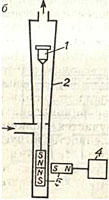 The industry produces rotameters with glass and metal tubes. For rotameters with a glass tube, the scale is printed directly on the surface of the tube. For remote measurement of the position of a float in a metal tube, intermediate linear displacement converters are used into a unified electrical or pneumatic signal.
The industry produces rotameters with glass and metal tubes. For rotameters with a glass tube, the scale is printed directly on the surface of the tube. For remote measurement of the position of a float in a metal tube, intermediate linear displacement converters are used into a unified electrical or pneumatic signal. In rotameters with an electrical output signal, the plunger of the differential transformer transducer moves with the float. Flowmeters with a pneumatic output signal use a magnetic coupling to transmit the float position to the transmitter. It consists of two permanent magnets. One - double - moves along with the float, the other, mounted on the lever of the displacement to compressed air pressure converter, moves along with the lever after the first magnet.
Rotameters are also available for measuring the flow of highly aggressive media. Rotameters are supplied with a jacket for steam heating. They are designed to measure the flow of crystallizing media.
Variable Level Flowmeters
From hydraulics it is known that if the liquid flows freely through the hole in the bottom of the tank, then its flow rate Q and the level in the tank H are interconnected. Therefore, by the level in the tank, one can judge the flow from it.
This principle is the basis for the operation of variable level flowmeters. It is obvious that the role of the primary converter here is played by the tank itself with a hole in the bottom. The output signal of such a converter is the level in the tank. Therefore, any of the considered level gauges can serve as an intermediate converter of the measuring circuit of the variable level flowmeter.
Variable level meters are commonly used to measure the flow of aggressive and contaminated liquids when they are discharged into tanks at atmospheric pressure.
Electromagnetic flowmeters
 The operation of electromagnetic flowmeters is based on the law electromagnetic induction, according to which e will be induced in a conductor moving in a magnetic field. d.s., proportional to the speed of the conductor. In electromagnetic flow meters, the role of a conductor is performed by an electrically conductive liquid flowing through pipeline 1 and crossing the magnetic field 3 of an electromagnet 2. In this case, an e will be induced in the liquid. d.s. U, proportional to the speed of its movement, i.e., the flow rate of the liquid.
The operation of electromagnetic flowmeters is based on the law electromagnetic induction, according to which e will be induced in a conductor moving in a magnetic field. d.s., proportional to the speed of the conductor. In electromagnetic flow meters, the role of a conductor is performed by an electrically conductive liquid flowing through pipeline 1 and crossing the magnetic field 3 of an electromagnet 2. In this case, an e will be induced in the liquid. d.s. U, proportional to the speed of its movement, i.e., the flow rate of the liquid. The output signal of such a primary converter is taken by two insulated electrodes 4 and 6 installed in the pipeline wall. The section of the pipeline on both sides of the electrodes is covered with electrical insulation 7 to prevent shunting of the induced e. d.s. through the liquid and the pipeline wall.
The degree of aggressiveness of the measured media for electromagnetic flowmeters is determined by the insulation material of the pipe and electrodes of the primary converter. In flowmeters, rubber, acid-resistant enamel and fluoroplastic are used for this purpose. The most resistant to aggressive media is a flowmeter with a fluoroplastic insulating coating and graphitized fluoroplast electrodes.
During the operation of the flow meters, the zero and calibration of the device should be checked periodically, at least once a week. To check the primary converter is filled with the measured liquid. After that, the operation mode switch on the front panel of the measuring unit is moved to the "Measurement" position and the pointer of the measuring device is set to zero with the "Zero" potentiometer. When the switch is moved to the "Calibration" position, the arrow of the device should stop at 100%. Otherwise, the arrow is brought to this mark by the "Calibration" potentiometer.
A distinctive feature of electromagnetic flowmeters is the absence of additional pressure losses in the area. measurements. This is due to the absence of parts protruding into the pipe. A particularly valuable property of such flowmeters, in contrast to other types of flowmeters, is the ability to measure the flow rate of aggressive, abrasive and viscous liquids and slurries.
Ultrasonic flow meters
The operation of these flowmeters is based on the addition of the speed of propagation of ultrasound in the liquid and the speed of the liquid flow itself. The emitter and receiver of the ultrasonic pulses of the flow meter are located at the ends of the measuring section of the pipeline. The electronic unit contains a pulse generator and a time meter for the pulse to travel the distance between the emitter and the receiver.
Before starting operation, the flow meter is filled with the liquid, the flow rate of which will be measured, and the time it takes the pulse to travel this distance in a stagnant medium is determined. When the flow moves, its speed will add up with the speed of ultrasound, which will lead to a decrease in the pulse travel time. This time, converted in the block into a unified current signal, will be the smaller, the greater the flow rate, i.e., the greater its consumption Q.
Ultrasonic flowmeters have the same advantages as electromagnetic flowmeters, and, in addition, they can measure the flow of non-conductive liquids.
Vortex meters
The operation of such flowmeters is based on the occurrence of vortices when a flow meets a non-streamlined body. During operation of the flow meter, the vortices are detached alternately from opposite sides of the body located across the flow. The vortex separation frequency is directly proportional to the flow velocity, i.e., its volumetric flow rate Q. At the site of the vortex, the flow velocity increases, and the pressure decreases. Therefore, the frequency of the formation of vortices can be measured, for example, with a pressure gauge, the electrical output of which is fed to a frequency meter.
Thermal flow meters
 The thermal flow meter consists of a heater 1 and two temperature sensors 2 and 3, which are installed outside the tube 4 with the measured flow. At constant power heater, the amount of heat taken from it by the flow will also be constant. Therefore, with an increase in flow rate Q, the heating of the flow will decrease, which is determined by the temperature difference measured by temperature sensors 3 and 2. To measure high flow rates, not the entire flow Q is measured, but only its part Q1, which is passed through tube 4. This tube shunts pipeline section 5 , equipped with a choke 6. The flow area of the choke determines the upper limit of the range of measured flow rates: the larger this section, the greater the flow rate can be measured (at the same heater power).
The thermal flow meter consists of a heater 1 and two temperature sensors 2 and 3, which are installed outside the tube 4 with the measured flow. At constant power heater, the amount of heat taken from it by the flow will also be constant. Therefore, with an increase in flow rate Q, the heating of the flow will decrease, which is determined by the temperature difference measured by temperature sensors 3 and 2. To measure high flow rates, not the entire flow Q is measured, but only its part Q1, which is passed through tube 4. This tube shunts pipeline section 5 , equipped with a choke 6. The flow area of the choke determines the upper limit of the range of measured flow rates: the larger this section, the greater the flow rate can be measured (at the same heater power). Turbine meters
In such flowmeters, the measured flow drives an impeller that rotates in bearings. The speed of rotation of the impeller is proportional to the flow rate, i.e., the flow rate Q. To measure the speed of rotation of the impeller, its housing is made of a non-magnetic material. A differential transformer converter is installed outside the housing, and an edge is made of a ferromagnetic material at one of the blades of the turbine. When this blade passes by the converter, its inductive reactance changes and, with a frequency proportional to the flow rate Q, the voltage on the secondary windings U out changes. Measuring device Such a flow meter is a frequency meter that measures the frequency of voltage changes.
Speed counters
These meters are similar in design to turbine flow meters. The difference between them lies in the fact that the speed of rotation of the turbine is measured in flow meters, and the number of its revolutions is measured in meters, which is then converted to the amount of liquid that has passed through the meter for the time interval of interest to us, for example, per month.
1. Liquid state of matter and its properties.
2.1 Bernoulli's law.
2.2 Pascal's law.
2.3 Laminar flow of liquids.
2.4 Poisel's law.
2.5 Turbulent flow of liquids.
3.1 Measuring the viscosity of a liquid.
3.2 Liquid volume and flow measurement
1. Liquid state of matter and its properties.
Liquids occupy an intermediate position between gaseous and solid substances. At temperatures close to boiling points, the properties of liquids approach those of gases; at temperatures close to melting points, the properties of liquids approach those of solids. If solid substances are characterized by a strict ordering of particles, extending over distances of up to hundreds of thousands of interatomic or intermolecular radii, then in a liquid substance there are usually no more than a few tens of ordered particles - this is explained by the fact that the ordering between particles in different places of a liquid substance also quickly arises. , as well as again "smeared" by the thermal vibration of particles. At the same time, the total packing density of particles of a liquid substance differs little from that of a solid substance - therefore, their density is close to the density of solids, and the compressibility is very low. For example, to reduce the volume occupied by liquid water by 1%, it is required to apply a pressure of ~ 200 atm, while the same decrease in the volume of gases requires a pressure of the order of 0.01 atm. Therefore, the compressibility of liquids is approximately 200: 0.01 = 20,000 times less than the compressibility of gases.
It was noted above that liquids have a certain volume of their own and take the shape of the vessel in which they are located; these properties are much closer to those of a solid than a gaseous substance. The close proximity of the liquid state to the solid state is also confirmed by the data on the standard enthalpies of vaporization ∆Н° test and the standard enthalpies of melting ∆Н° pl. The standard enthalpy of vaporization is the amount of heat required to convert 1 mole of liquid to vapor at 1 atm (101.3 kPa). The same amount of heat is released when 1 mole of vapor condenses into a liquid at 1 atm. The amount of heat spent on the transformation of 1 mol of a solid into a liquid at 1 atm is called the standard enthalpy of fusion (the same amount of heat is released when 1 mol of liquid at 1 atm “freezes” (“solidifies”). It is known that ∆Н° pl is much less than the corresponding values of ∆Н° exp, which is easy to understand, since the transition from a solid to a liquid state is accompanied by a smaller violation of intermolecular attraction than a transition from a liquid to a gaseous state.
A number of other important properties of liquids are more reminiscent of the properties of gases. So, like gases, liquids can flow - their property is called fluidity. The resistance to flow is determined by the viscosity. Fluidity and viscosity are affected by attractive forces between liquid molecules, their relative molecular weight, and a number of other factors. The viscosity of liquids is ~100 times greater than that of gases. Just like gases, liquids can diffuse, albeit much more slowly, since liquid particles are packed much more densely than gas particles.
One of the most important properties of a liquid is its surface tension (this property is not inherent in either gases or solids). A molecule in a liquid is subjected to uniform intermolecular forces from all sides. However, on the surface of the liquid, the balance of these forces is disturbed, and as a result, the “surface” molecules are under the action of a certain resultant force directed inside the liquid. For this reason, the surface of the liquid is in a state of tension. Surface tension is the minimum force that restrains the movement of liquid particles into the depth of the liquid and thereby keeps the surface of the liquid from contracting. It is surface tension that explains the "teardrop" shape of freely falling fluid particles.
Due to volume conservation, the liquid is able to form a free surface. Such a surface is the phase interface of a given substance: on one side there is a liquid phase, on the other - a gaseous (steam), and, possibly, other gases, such as air. If the liquid and gaseous phases of the same substance are in contact, forces arise that tend to reduce the interface area - surface tension forces. The interface behaves like an elastic membrane that tends to shrink.
Surface tension can be explained by the attraction between liquid molecules. Each molecule attracts other molecules, seeks to "surround" itself with them, and therefore, to leave the surface. Accordingly, the surface tends to decrease. Therefore, soap bubbles and bubbles during boiling tend to take on a spherical shape: for a given volume, a ball has a minimum surface. If only surface tension forces act on a liquid, it will necessarily take on a spherical shape - for example, water drops in weightlessness.
Small objects with a density greater than the density of a liquid are able to "float" on the surface of the liquid, since the force of gravity is less than the force that prevents the increase in surface area.
Wetting is a surface phenomenon that occurs when a liquid contacts a solid surface in the presence of steam, that is, at the interfaces of three phases. Wetting characterizes the “sticking” of a liquid to the surface and spreading over it (or, conversely, repulsion and non-spreading). There are three cases: non-wetting, limited wetting and complete wetting.
Miscibility is the ability of liquids to dissolve in each other. An example of miscible liquids: water and ethyl alcohol, an example of immiscible liquids: water and liquid oil.
When two miscible liquids are in a vessel, as a result of thermal motion, the molecules begin to gradually pass through the interface, and thus the liquids gradually mix. This phenomenon is called diffusion (it also occurs in substances in other states of aggregation).
A liquid can be heated above the boiling point in such a way that boiling does not occur. This requires uniform heating, without significant temperature differences within the volume and without mechanical influences such as vibration. If something is thrown into a superheated liquid, it instantly boils. Superheated water is easy to get in the microwave.
Subcooling - cooling of a liquid below the freezing point without turning into a solid state of aggregation. As with superheating, subcooling requires the absence of vibration and significant temperature fluctuations.
If the surface of the liquid is displaced from the equilibrium position, then under the action of restoring forces, the surface begins to move back to the equilibrium position. This movement, however, does not stop, but turns into an oscillatory movement around the equilibrium position and spreads to other areas. This creates waves on the surface of a liquid.
If the restoring force is predominantly gravity, then such waves are called gravitational waves. Gravitational waves on water can be seen everywhere.
If the restoring force is predominantly a surface tension force, then such waves are called capillary. If these forces are comparable, such waves are called capillary-gravity waves. Waves on the surface of a liquid are attenuated by viscosity and other factors.
Formally speaking, for the equilibrium coexistence of a liquid phase with other phases of the same substance - gaseous or crystalline - strictly defined conditions are needed. So, at a given pressure, a strictly defined temperature is needed. Nevertheless, in nature and technology, everywhere liquid coexists with steam, or also with a solid state of aggregation - for example, water with water vapor and often with ice (if we consider steam as a separate phase present along with air). This is due to the following reasons.
Unbalanced state. It takes time for the liquid to evaporate, until the liquid has completely evaporated, it coexists with the vapor. In nature, water is constantly evaporating, as well as the reverse process - condensation.
closed volume. The liquid in a closed vessel begins to evaporate, but since the volume is limited, the vapor pressure rises, it becomes saturated even before the liquid has completely evaporated, if its amount was large enough. When the saturation state is reached, the amount of evaporated liquid is equal to the amount of condensed liquid, the system comes into equilibrium. Thus, in a limited volume, the conditions necessary for the equilibrium coexistence of liquid and vapor can be established.
The presence of the atmosphere in the conditions of terrestrial gravity. Atmospheric pressure acts on a liquid (air and steam), while for steam, practically only its partial pressure should be taken into account. Therefore, the liquid and the vapor above its surface correspond to different points on the phase diagram, in the region of the existence of the liquid phase and in the region of the existence of the gaseous, respectively. This does not cancel evaporation, but evaporation takes time during which both phases coexist. Without this condition, liquids would boil and evaporate very quickly.
2.1 Bernoulli's law - is a consequence of the law of conservation of energy for a stationary flow of an ideal (that is, without internal friction) incompressible fluid:
Liquid density,
flow rate,
The height at which the fluid element in question is located,
The pressure at the point in space where the center of mass of the fluid element under consideration is located,
Acceleration of gravity.
The constant on the right hand side is usually called pressure, or full pressure, and also Bernoulli integral. The dimension of all terms is a unit of energy per unit volume of liquid.
This ratio, derived by Daniel Bernoulli in 1738, was named after him. Bernoulli equation. For horizontal pipe h= 0 and the Bernoulli equation takes the form:
![]() .
.
This form of the Bernoulli equation can be obtained by integrating the Euler equation for a stationary one-dimensional fluid flow, at a constant density ρ:
![]() .
.
According to Bernoulli's law, the total pressure in a steady flow of fluid remains constant along this flow.
Full pressure consists of the weighted (ρ gh), static (p) and dynamic (ρν 2 /2) pressures.
It follows from Bernoulli's law that as the flow cross section decreases, due to an increase in velocity, that is, dynamic pressure, the static pressure decreases. This is the main reason for the Magnus effect. Bernoulli's law is also valid for laminar gas flows. The phenomenon of a decrease in pressure with an increase in the flow rate underlies the operation of various types of flow meters (for example, a Venturi tube), water and steam jet pumps. And the consistent application of Bernoulli's law led to the emergence of a technical hydromechanical discipline - hydraulics.
Bernoulli's law is valid in its pure form only for liquids whose viscosity is zero, that is, liquids that do not stick to the surface of the pipe. In fact, it has been experimentally established that the velocity of a liquid on the surface of a solid body is almost always exactly zero (except in cases of jet separation under certain rare conditions).
2.2 Pascal's lawis formulated like this:
D 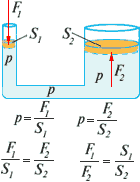 The pressure exerted on a liquid (or gas) in any one place on its boundary, for example, by a piston, is transmitted without change to all points of the liquid (or gas).
The pressure exerted on a liquid (or gas) in any one place on its boundary, for example, by a piston, is transmitted without change to all points of the liquid (or gas).
Basic property of liquids and gases- transfer pressure without change in all directions - is the basis for the design of hydraulic and pneumatic devices and machines.






